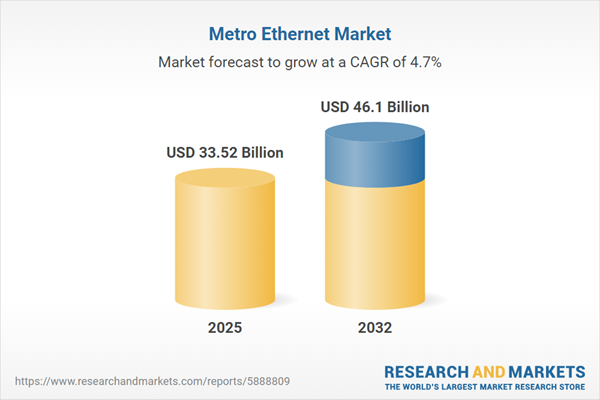Speak directly to the analyst to clarify any post sales queries you may have.
Metro Ethernet is central to enterprise network modernization, offering a flexible, secure, and high-capacity connectivity framework for organizations operating across multiple sites. Its broad adaptability helps streamline operations and foster efficient IT management throughout regional and global entities.
Market Snapshot: Metro Ethernet Market Size and Growth
The Metro Ethernet market is achieving solid growth, with projections indicating a rise from USD 32.03 billion in 2024 to USD 33.52 billion by 2025. By 2032, the expected market size is USD 46.10 billion, reflecting a 4.65% CAGR. Market momentum is sustained by the growing transition to cloud-based services, heightened awareness of secure network environments, and the continual demand to connect distributed enterprises efficiently. This trend highlights Metro Ethernet’s expanding role in supporting robust, agile IT transformations for businesses worldwide.
Scope & Segmentation of the Metro Ethernet Market
The report provides senior executives, technology strategists, and institutional investors with clear guidance to refine Metro Ethernet deployment and investment strategies. Segmentation analysis helps spotlight areas for optimization and competitive differentiation across the following categories:
- Connectivity Types: E-Lan streamlines teamwork across dispersed locations, E-Line ensures dedicated and secure point-to-point connections, and E-Tree structures manage complex organizational hierarchies with tailored access.
- Bandwidth Tiers: Entry-level services support essential connectivity for remote offices, scalable bandwidth options enable organizations to meet evolving operational requirements, and higher tiers accommodate substantial data volumes and digitalized workflows.
- Service Types: Managed services minimize operational burden and support innovation by handling day-to-day network management, while unmanaged services give enterprises direct control over customization and performance.
- Industry Verticals: Banking and finance emphasize integrated compliance and security. Public sector and healthcare focus on privacy and governance, IT/telecom demand uninterrupted availability, manufacturers automate for efficiency, and retail prioritizes steady networks for superior customer experiences.
- Regions & Subregions: The scope includes North America’s well-established Metro Ethernet ecosystem, growth-driven investments in Latin America, Asia-Pacific’s expanding digital transformation, and advances in Middle Eastern digital infrastructure.
- Leading Providers Profiled: AT&T Inc., Verizon Communications Inc., Lumen Technologies, NTT Communications Corporation, Comcast Corporation, Deutsche Telekom AG, Orange S.A., BT Group plc, Vodafone Group Plc, and Tata Communications Limited. Firms are benchmarked by their solutions and partnership approaches.
Key Takeaways for Senior Decision-Makers
- Metro Ethernet reinforces secure, real-time communication and collaboration for dispersed enterprises, empowering decisive, agile operational shifts.
- Adopting managed networking shifts technical load off internal teams, aligning resources toward business transformation and sustained innovation.
- Advancement through software-defined networking and network function virtualization strengthens network adaptability and supports rapid deployment of new services.
- Support for sector-specific compliance helps organizations navigate evolving privacy and security requirements, which is critical for regulated markets.
- Aligned strategies between telecom carriers, technology vendors, and cloud service providers enhance unified, resilient network environments.
- Tailoring connectivity approaches to each geographic market ensures compliance with local operational and regulatory dynamics and positions enterprises for scalable growth.
Tariff Impact on Metro Ethernet Strategy
Impending U.S. tariffs in 2025 are poised to influence Metro Ethernet hardware supply chains, particularly for optical modules and switches. Enterprises and service providers are responding by diversifying vendor engagement, refining procurement planning, and increasing adoption of managed services to manage continuity risks. Scenario planning and proactive risk assessment are key to sustaining stable network operations and minimizing supply disruptions.
Methodology & Data Sources
The analysis synthesizes insights from interviews with senior executives and network architects at leading providers. Data were vetted through technical white papers, regulatory documents, and perspectives from compliance and network virtualization specialists to ensure comprehensive, reliable reporting.
Why This Report Matters
- This report presents a complete overview of Metro Ethernet market dynamics and evolving segment trends, empowering executive leadership to make informed investment and deployment decisions.
- Senior decision-makers can benchmark network strategies, identify priority service models, and stay ahead of changes in enterprise connectivity needs with a clear, actionable framework.
- Integrated technical, compliance, and cloud transformation insights support well-informed choices that align with organizational objectives and digital transformation goals.
Conclusion
Metro Ethernet underpins enterprise resilience by ensuring stable, adaptable networking for modern operations. Cross-functional integration of connectivity and governance enables organizations to sustain progress and realize their digital potential.
Additional Product Information:
- Purchase of this report includes 1 year online access with quarterly updates.
- This report can be updated on request. Please contact our Customer Experience team using the Ask a Question widget on our website.
Table of Contents
3. Executive Summary
4. Market Overview
7. Cumulative Impact of Artificial Intelligence 2025
Companies Mentioned
The companies profiled in this Metro Ethernet market report include:- AT&T Inc.
- Verizon Communications Inc.
- Lumen Technologies, Inc.
- NTT Communications Corporation
- Comcast Corporation
- Deutsche Telekom AG
- Orange S.A.
- BT Group PLC
- Vodafone Group PLC
- Tata Communications Limited
Table Information
| Report Attribute | Details |
|---|---|
| No. of Pages | 195 |
| Published | November 2025 |
| Forecast Period | 2025 - 2032 |
| Estimated Market Value ( USD | $ 33.52 Billion |
| Forecasted Market Value ( USD | $ 46.1 Billion |
| Compound Annual Growth Rate | 4.6% |
| Regions Covered | Global |
| No. of Companies Mentioned | 11 |









